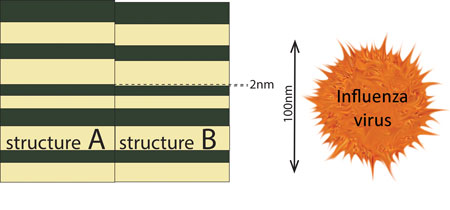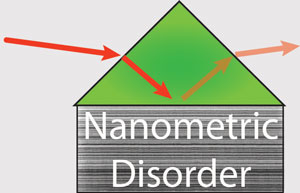| Posted: Jun 06, 2017 |
Sensing the nanoscale with visible light
(Nanowerk News) A general rule in optics is that light is insensitive to features which are much smaller than the optical wavelength. In fact, the whole concept of “index of refraction” arises from the fact that light experiences a medium as a whole, not responding to the individual atoms. However, a new experiment at the Technion-Israel Institute of Technology Physics Department shows that even features that are more than 100 times smaller than the wavelength can still be sensed by light.
|
|
Published in Science ("Observation of Anderson localization in disordered nanophotonic structures"), the work - conducted by Hanan Herzig Sheinfux and Dr. Yaakov Lumer from the group of Distinguished Professor Mordechai (Moti) Segev from the Technion, in collaboration with Dr. Guy Ankonina and Prof. Guy Bartal (Technion), and Prof. Azriel Genack (City University of New York) - examines a stack of nanometrically thin layers – each of which is on average 20,000 times thinner than a sheet of paper.
|
 |
| Scale of magnitude: two nearly-identical structures and a Flu virus.
|
|
The exact thickness of the layers is purposely random. Ordinarily, this nanometric disorder should bear no physical importance: light just experiences the average properties, as if this were a homogeneous medium. But, in this experiment, a 2nm (~6 atoms) thickness increase to one single layer somewhere inside the structure is enough to change the amount of light reflected at a specific angle of incidence.
|
|
Furthermore, the combined effect of all the random variations in all the layers manifests an important physical phenomenon called Anderson localization, but in a regime where it was believed to have vanishingly small effects.
|
|
Wave localization was first discovered in 1958 by Philip W. Anderson, who was awarded the Nobel Prize for it in 1977. Anderson localization is a notoriously difficult effect to demonstrate in the lab. In particular, when the random features of a sample are much smaller than the wavelength, Anderson localization has practically no effect.
|
|
Indeed, the random arrangement of the atoms in a material such as glass is not observable with visible light: the glass looks completely homogeneous, even under the best optical microscope. But the localization effect seen in this recent experiment is surprisingly potent.
|
 |
| Illustration of the disordered system.
|
|
How is this possible? Imagine being pushed by a mosquito. Normally, mosquitos are too weak to push anything as heavy as a grown person. However, if you happen to be walking on a tightrope, even a relatively small shove can have a large effect - all the other forces are balanced and the effect of the mosquito is still effectively amplified (technically, a mosquito's shove is so weak, that this amplification would likely be ineffective, but the principle remains).
|
|
In a crude analogue, while nanometric disorder is very weak, this experiment was conducted near the threshold of total internal reflection - a point of fragile stability, analogous to standing on the tight-rope - and the influence of disorder was effectively amplified.
|
|
These findings are a proof-of-concept which could pave the way for major new applications in sensing. This approach may allow the use of optical methods to make measurements of nanometric defects in computer chips and photonic devices. Since such an optical approach is expected to be faster and less expensive than measurements using electrons or X-rays, these results have a significant potential impact for manufacturing technology and basic science.
|


